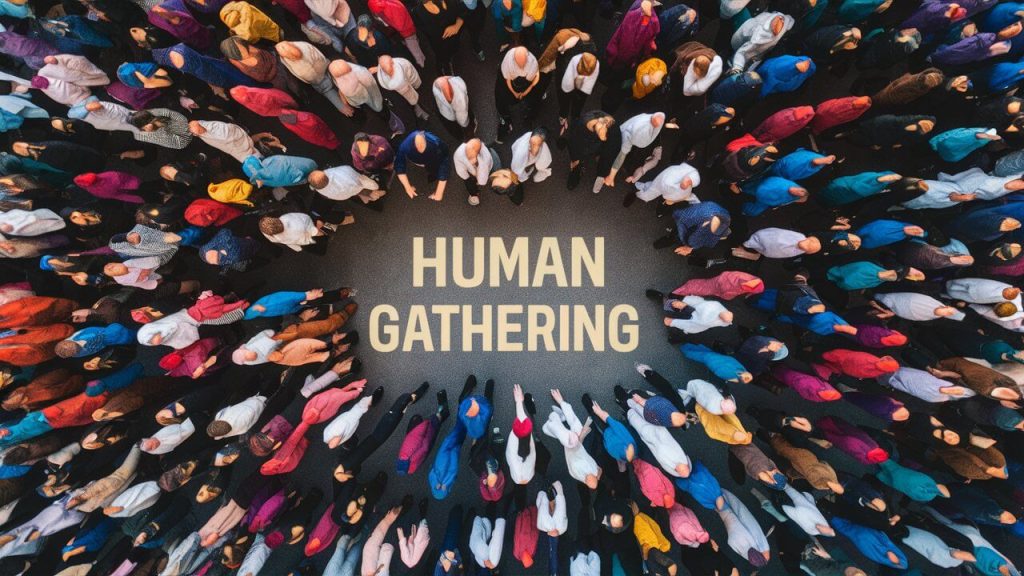The phenomenon of human gathering fake has become increasingly prevalent in the age of social media and technology. This concerning issue involves the fabrication and promotion of events that deceive and manipulate users for various purposes. These fabricated events, often spread through online platforms, have the potential to mislead individuals, shape public opinion, and even influence real-world outcomes.
Fake gatherings can take many forms, ranging from political rallies and protests to charity events and social gatherings. They are designed to mimic authentic human gatherings, complete with staged attendees, manipulated visuals, and false narratives. The goal is to create an illusion of mass participation and support, garnering attention and credibility for the organizers.
Examples of such fabricated events abound. One notable case is the infamous Fyre Festival, a music festival that was heavily promoted on social media but ultimately turned out to be a disaster. Attendees were promised a luxurious experience on a private island with A-list musical performances, but instead found themselves stranded without proper accommodations or basic necessities.
Another example is the “Million Dollar Homepage” project, where an individual sold advertising space on a webpage pixel by pixel. The project gained traction through online promotion and successfully generated substantial revenue.
These examples highlight the potential for fake gatherings to exploit people’s trust and manipulate their perceptions. By capitalizing on social media’s amplifying effect and leveraging technology’s advancements in visual manipulation, these fabricated events can easily deceive unsuspecting users.
The Impact of Social Media and Technology
Social media has a powerful role in spreading fake news rapidly, especially when it comes to fake events. This is a significant concern in today’s tech-driven world. Technological advancements have made it easier for people to organize and promote fake gatherings for personal or hidden reasons. They can create event pages that look real, share edited images, and use targeted ads to reach more people.
One key factor in the spread of fake gatherings is social media algorithms. These algorithms prioritize sensational content, which can make fake events go viral. Their main goal is to keep users engaged by showing them content that will provoke strong emotions, often favoring controversy and novelty over accuracy. As a result, deceptive events can quickly gain popularity and visibility, reaching a large audience before anyone questions their authenticity.
Understanding the influence of social media algorithms is crucial in dealing with fake gatherings. It reminds us of the importance of:
- Being Critical: Always question information and verify its accuracy before believing or sharing it.
- Developing Digital Literacy: Acquire skills to navigate online platforms effectively and distinguish between genuine and fabricated events.
By being proactive in evaluating information and enhancing our digital literacy, we can better protect ourselves from falling victim to fake gatherings on social media platforms.
Cognitive Biases and Information Evaluation
Cognitive biases play a significant role in shaping our perceptions and decision-making processes, often leading individuals to accept deceptive narratives without critical evaluation. Confirmation bias, for example, can cause people to seek out information that aligns with their preconceived beliefs, making them more vulnerable to accepting fake gatherings at face value.
1. Understanding Cognitive Biases
Explore the cognitive biases that make people susceptible to believing in and sharing deceptive narratives like fake gatherings.
2. Importance of Fact-Checking
Highlight the importance of maintaining information integrity by fact-checking and verifying sources before accepting the authenticity of an event.
3. Role of Digital Literacy
Discuss the role of digital literacy skills in critically evaluating multimedia content associated with alleged human gathering fakes.
Maintaining information integrity is crucial in combatting the spread of fabricated events. Fact-checking and verifying sources before sharing or endorsing an alleged human gathering can help prevent the perpetuation of deceptive content. By encouraging critical thinking and skepticism, individuals can contribute to a more informed and discerning online community.
Digital literacy skills are essential for navigating the contemporary landscape of multimedia content. Being able to critically evaluate images, videos, and textual information associated with purported human gatherings enables individuals to identify potential inconsistencies or manipulations that may indicate falsified events. Strengthening digital literacy empowers users to approach online content with a discerning eye, mitigating the impact of fake gatherings on social media and digital platforms.

The Evolution of Fake Gatherings in the Digital Age
Fake gatherings are not a new phenomenon, and their existence predates the digital age. Throughout history, individuals have organized events with the intention to deceive or manipulate others for personal or ulterior motives. However, advancements in technology and the rise of online platforms have provided new opportunities for orchestrating large-scale deceptive events.
1. Historical Roots
Fake gatherings can be traced back to ancient times when rulers would stage grand spectacles or festivals to project power and influence. These events often aimed to create an illusion of unity and prosperity, deceiving both the participants and observers. In more recent history, political rallies and public demonstrations have also been manipulated to generate a false sense of support or dissent.
2. Online Platforms
The emergence of online platforms has further amplified the scale and impact of fake gatherings. Platforms like The Human Gathering have enabled individuals to create private networks where they can orchestrate elaborate events that appear authentic but are ultimately fabricated. These events can range from conferences and meetups to performances and protests. Notable case studies include instances where influencers organized gatherings that promised exclusive experiences but turned out to be fraudulent.
3. Influential Leaders
One concerning aspect of fake gatherings in the digital age is the involvement of influential leaders. These leaders, often revered by their followers, can exploit their position of trust to organize large-scale deceptive events. When influential figures perpetuate fake gatherings, it not only erodes trust within their communities but also has broader societal consequences. The credibility of these leaders may be called into question, leading to disillusionment among their followers.
The evolution of fake gatherings highlights the need for vigilance in evaluating the authenticity of events, regardless of historical context or technological advancements. As technology continues to advance, it is crucial for individuals to exercise critical thinking skills and verify sources before accepting the legitimacy of any gathering. By understanding the historical roots and current trends associated with fake gatherings, individuals can better navigate the digital landscape and protect themselves from manipulation and deception.
Detecting and Debunking Human Gathering Fakes
When it comes to identifying and addressing human gathering fakes, there are several strategies and tools that individuals can employ to maintain information integrity and build trust within their communities. Here are some key talking points to consider:
1. Practical Strategies and Tools
It is essential for individuals to be vigilant in verifying the authenticity of suspicious events. One effective approach is to conduct reverse image searches to determine if the visuals associated with a gathering have been used in other contexts or if they appear manipulated. Additionally, cross-referencing multiple news sources can help in validating the occurrence of an event and identifying any discrepancies in reported details.
2. Role of Trustworthy Community Members
Trustworthy community members play a crucial role in debunking fake gatherings. Through collaborative investigation and evidence-sharing, these individuals can contribute to exposing the deceptive nature of fabricated events. By fostering an environment of transparency and accountability, community members can collectively work towards safeguarding the integrity of genuine gatherings.
3. Ethical Considerations
When addressing human gathering fakes, it is important to navigate ethical considerations thoughtfully. Publicly exposing individuals or groups behind orchestrated fake gatherings requires careful consideration of potential consequences and the impact on affected parties. Balancing the pursuit of truth with responsible disclosure is paramount in maintaining ethical standards while combating deceptive practices.
By leveraging these strategies and recognizing the contributions of trustworthy community members, individuals can actively participate in the detection and debunking of human gathering fakes, ultimately contributing to a more informed and authentic communal experience.
The Future of Authentic Community Building
As technology continues to shape our interactions and communities, the future of authentic community building requires innovative approaches that prioritize integrity, trustworthiness, and meaningful connections. Here are two key aspects to consider:
1. Adoption of Hybrid Event Models
To promote integrity and trustworthiness in online and offline communities, the adoption of hybrid event models that combine virtual and in-person interactions can play a significant role. These models offer the flexibility to engage with a broader audience while maintaining the authenticity of face-to-face interactions. By blending the best elements of both virtual and physical gatherings, hybrid events provide opportunities for individuals to connect, share ideas, and build relationships.
Virtual Engagement
Virtual components allow individuals from different locations to participate in community-building activities, fostering inclusivity and expanding reach. Through live streaming, interactive chat rooms, and virtual breakout sessions, people can connect with others who share similar interests or goals.
In-Person Connection
Physical gatherings still hold immense value in fostering deeper connections and emotional bonds. By incorporating well-designed spaces for face-to-face interactions within hybrid events, attendees can engage in authentic conversations and build stronger relationships.
2. The Responsibility of Successful Individuals
Successful individuals have a unique responsibility in upholding ethical standards and fostering genuine connections within their spheres of influence. As influential leaders or public figures, they have the power to shape narratives and impact communities positively.
- Leading by Example: Successful individuals should prioritize authenticity and transparency in their own interactions, both online and offline. By demonstrating genuine care for their audience or followers, they set a precedent for others to follow.
- Empowering Others: Alongside leading by example, successful individuals can empower their communities by providing platforms for authentic engagement. This may involve organizing events that encourage participation and collaboration or supporting initiatives that foster meaningful connections.
By embracing hybrid event models, local mitigation planning, and encouraging responsible community-building practices, we can pave the way for a future where authenticity and trust are valued above all. Together, we can create communities that prioritize genuine connections and meaningful interactions, both online and offline. Research studies like those found in the Journal of Economic Interaction and Coordination or Pew Research Center provide valuable insights into these aspects of community building.
Conclusion
It is important to remember the importance of being aware and cautious when it comes to fake events, while also nurturing real community experiences. This is essential in our efforts to improve the world we live in.
By actively taking part in initiatives that promote media literacy education and responsible use of social media, each individual has the power to contribute towards a society that is more knowledgeable and discerning. This means being responsible for critically analyzing information and verifying its sources, which in turn helps us fight against the spread of misleading stories.
Ultimately, this leads to a culture where honesty and reliability are valued both online and offline. Through working together and holding ourselves accountable to ethical standards, we can strive towards a future where genuine connections and meaningful interactions are at the forefront.
Let’s work towards creating a world where genuine connections and meaningful interactions prevail, making the future of human gatherings more enriching and impactful for all.
